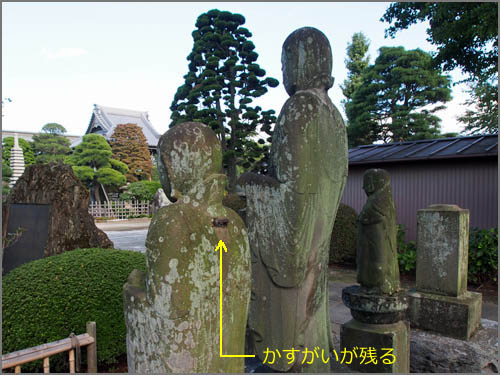https://darumamuseum.blogspot.jp/2007/04/kabuki-daruma.html
Daruma with the special KUMADORI 隈取りmake-up of a kabuki actor.
- quote -
Kumadori (隈取) is stage makeup worn by kabuki actors,
particularly when performing in the bold and bombastic aragoto style. Kumadori makeup generally consists of brightly colored stripes or patterns over a white foundation, the colors and patterns symbolizing aspects of the actor's character. Though kumadori was originated and developed extensively by members of the Ichikawa Danjūrō line of actors, some conventions are creations of the Onoe Kikugorō line.
- - - More in the WIKIPEDIA !

:::::::::::::::::::::::::::::::::::::::::::::::::::::::::::::::::::::::::::::::::::::::::::::::::::

renjishi 連獅子 dance of two lions
- quote -
The dance "Renjishi"
was staged for the first time in 1861, starring the dance master Hanayagi Jusuke I and his son Hanayagi Yoshijirô. The music was written by Kineya Katsusaburô II and his piece was called "Katsusaburô Renjishi". The first performance of this dance with Kabuki actors occured in the 7th lunar month of 1872 at the Murayamaza, starring Bandô Hikosaburô V and Sawamura Tosshô II in the roles of the shishi parent and cub. The music piece for this performance was not "Katsusaburô Renjishi", but a new piece written by Kineya Shôjirô III and called "Shôjirô Renjishi".
The theme of "Renjishi" stays close to that of the Nô play "Shakkyô", and it is classified as a matsubame dance. That is, a dance that's performed before the symbolic backdrop of a large pine tree flanked by bamboo which is copied from the Nô stage. This scenery has no connection with the dance's content. The first section features a pair of Kyôgen actors who come to dance the story of the shishi parent and cub. The actors each carry a wooden mask of a shishi head, one with white hair representing the parent shishi and the other with red hair to represent its child. A shishi is a mythological lion-like animal said to be the king of beasts and always associated with the Buddhist deity Monju. For this reason, any portrayal of the shishi should not only bring out its wild, beastial nature, but also a sense of dignity and authority that goes with this divine status.
The shishi is in many ways a spiritual creature.
- story -
This dance has come to be staged often recently and is popular for its spectacular ending as well as for the opportunity to see a father and son combination of actors in the leading roles. A special version with one father and 2 cubs was created for Nakamura Kankurô and his two sons, Nakamura Kantarô and Nakamura Shichinosuke.
- source : kabuki21.com/renjishi -
:::::::::::::::::::::::::::::::::::::::::::::::::::::::::::::::::::::::::::::::::::::::::::::::::::
Beckoning Cat with Kabuki Makeup

2004 Kasukabe Hariko Ningyo Ten - exhibition
.
Daruma with the special KUMADORI 隈取りmake-up of a kabuki actor.
- quote -
Kumadori (隈取) is stage makeup worn by kabuki actors,
particularly when performing in the bold and bombastic aragoto style. Kumadori makeup generally consists of brightly colored stripes or patterns over a white foundation, the colors and patterns symbolizing aspects of the actor's character. Though kumadori was originated and developed extensively by members of the Ichikawa Danjūrō line of actors, some conventions are creations of the Onoe Kikugorō line.
- - - More in the WIKIPEDIA !

:::::::::::::::::::::::::::::::::::::::::::::::::::::::::::::::::::::::::::::::::::::::::::::::::::

renjishi 連獅子 dance of two lions
- quote -
The dance "Renjishi"
was staged for the first time in 1861, starring the dance master Hanayagi Jusuke I and his son Hanayagi Yoshijirô. The music was written by Kineya Katsusaburô II and his piece was called "Katsusaburô Renjishi". The first performance of this dance with Kabuki actors occured in the 7th lunar month of 1872 at the Murayamaza, starring Bandô Hikosaburô V and Sawamura Tosshô II in the roles of the shishi parent and cub. The music piece for this performance was not "Katsusaburô Renjishi", but a new piece written by Kineya Shôjirô III and called "Shôjirô Renjishi".
The theme of "Renjishi" stays close to that of the Nô play "Shakkyô", and it is classified as a matsubame dance. That is, a dance that's performed before the symbolic backdrop of a large pine tree flanked by bamboo which is copied from the Nô stage. This scenery has no connection with the dance's content. The first section features a pair of Kyôgen actors who come to dance the story of the shishi parent and cub. The actors each carry a wooden mask of a shishi head, one with white hair representing the parent shishi and the other with red hair to represent its child. A shishi is a mythological lion-like animal said to be the king of beasts and always associated with the Buddhist deity Monju. For this reason, any portrayal of the shishi should not only bring out its wild, beastial nature, but also a sense of dignity and authority that goes with this divine status.
The shishi is in many ways a spiritual creature.
- story -
This dance has come to be staged often recently and is popular for its spectacular ending as well as for the opportunity to see a father and son combination of actors in the leading roles. A special version with one father and 2 cubs was created for Nakamura Kankurô and his two sons, Nakamura Kantarô and Nakamura Shichinosuke.
- source : kabuki21.com/renjishi -
:::::::::::::::::::::::::::::::::::::::::::::::::::::::::::::::::::::::::::::::::::::::::::::::::::
Beckoning Cat with Kabuki Makeup

2004 Kasukabe Hariko Ningyo Ten - exhibition
.








































